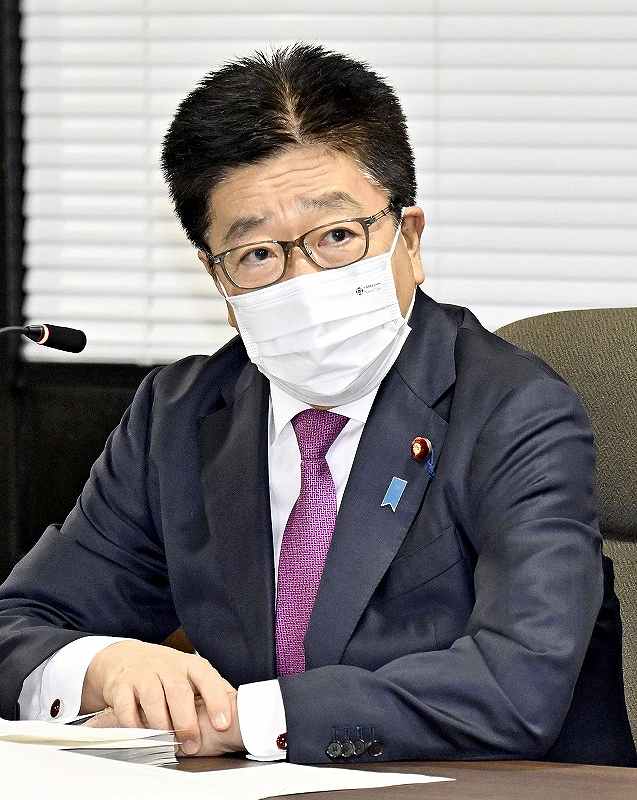
Health, Labor and Welfare Minister Katsunobu Kato addresses a meeting of a COVID-19 advisory body in Kasumigaseki, Tokyo, on Wednesday.
17:26 JST, December 15, 2022
Government deliberations over whether to lower the official classification of COVID-19, which would change how the virus is handled, will get into full swing following the presentation Wednesday of a risk assessment report by a health ministry advisory body.
However, based on the panel’s insistence that the novel coronavirus cannot be considered a disease on a par with seasonal influenza, the government will need to seek ways to make “living with COVID-19” a reality.
“It’s vital to ascertain how to understand the nature of the coronavirus, and what steps are necessary to combat it,” Takaji Wakita, head of the Health, Labor and Welfare Ministry’s advisory body and director general of the National Institute of Infectious Diseases, said at a press conference after the panel’s meeting. “I hope our risk assessment will become the foundation for future discussions.”
Wakita and three other key members of the panel compiled a risk assessment report at the request of Health, Labor and Welfare Minister Katsunobu Kato, detailing their views on factors including the pathogenicity of the novel coronavirus and the possibility of new variants emerging in the future.
The government is contemplating lowering COVID-19’s classification under the Infectious Disease Control Law from its current level of the equivalent of Category II, the second most severe category, to a Category V level disease, the same level as seasonal influenza. The omicron variant of COVID-19 has become dominant since the sixth wave of infections spread across Japan. The government’s position was prompted by the sharp decline in the risk of becoming seriously ill or dying from this variant.
Many local governments also have been calling for COVID-19’s classification to quickly be lowered. At Wednesday’s meeting, the Ibaraki prefectural government submitted an urgent request urging that COVID-19 be downgraded to a Category V disease. According to this prefectural government, the proportion of people aged 60 to 79 who became severely ill after catching the virus fell from 4.7% during the fifth wave in the summer of 2021 to just 0.4% during the seventh wave recorded in summer 2022. Influenza has the same rate of 0.4%.
Panel keeping guard up
Deeming the novel coronavirus to be on par with the flu would be a major step forward in reviewing COVID-19’s classification.
However, the panel’s experts stated that the virus is an infectious disease with “significantly different features” from the flu. As things stand, the panel held a negative view on treating COVID-19 and the flu equally. Different methods were used to collect data on the mortality rate and the proportion of infections that develop into severe cases, so making a simple comparison between the coronavirus and the flu is a stretch.
Furthermore, in addition to people whose coronavirus infection was a direct cause of death, there have been reports of infected people who died from complications with their heart and veins, so it is possible that authorities have not accurately grasped the true number of deaths arising from COVID-19.
COVID-19’s higher infectivity than influenza also is coming under the microscope. The repeated emergence of new variants has resulted in a continual spread of the virus, making the seasonality of this disease unclear and leading to multiple waves of infections during the year. In Japan, the numbers of new infections and deaths tend to increase each time there is a new wave. There are fears that a massive surge in infections could severely strain the medical system. The advisory body said “it will take quite some time” until COVID-19 becomes an infectious disease on the same level as influenza.
The possibility of new variants emerging is difficult to predict. The appearance of a variant that causes higher levels of severe illness would lead to a spike in the number of people requiring treatment in hospitals and place a huge burden on the medical system. The panel said there was no guarantee that the pathogenicity of future variants would be lower than existing variants.
April 2023 a date to watch
The government plans to reach a conclusion on COVID-19’s classification as soon as April next year, based on the advisory body’s risk analysis and after the current jump in infections has settled down. A subcommittee of an advisory body to the health minister will discuss the issue.
Opinion within the government is split over whether COVID-19 should be treated exactly the same as other Category V diseases if its classification is indeed lowered to that level. In particular, the cost of treatment for COVID-19 has been thrust into the spotlight. Currently, public funds cover COVID-19 treatment and vaccination expenses, but patients will need to pay part of these costs if the virus is bumped down to Category V.
Some officials at the health ministry, which has been considering treating the coronavirus just like the flu, favor ending the use of public funds to cover these expenses. However, the high cost of some medications has led to suggestions from within the government that public funds might continue to be available as an exception even after the virus is reclassified.
The government also is considering reviewing the classification of COVID-19 vaccines under the Immunization Law. These vaccines are currently considered “temporary vaccinations” that people can receive for free until the end of March 2023. An expert subcommittee of the health ministry will, by the end of this fiscal year, decide whether the public will have to pay for these vaccines out of their own pockets. Any increase in charges for medical treatment and vaccines is expected to trigger a backlash from the public, so the government plans to carefully consider this issue.
"Society" POPULAR ARTICLE
-

M4.9 Earthquake Hits Tokyo, Neighboring Prefectures
-

Israeli Tourists Refused Accommodation at Hotel in Japan’s Nagano Pref., Prompting Protest by Israeli Embassy and Probe by Prefecture
-

M7.5 Earthquake Hits Northern Japan; Tsunami Waves Observed in Hokkaido, Aomori and Iwate Prefectures
-

Tsukiji Market Urges Tourists to Avoid Visiting in Year-End
-

M5.7 Earthquake Hits Japan’s Kumamoto Pref., Measuring Upper 5 Intensity, No Tsunami Expected
JN ACCESS RANKING
-

Keidanren Chairman Yoshinobu Tsutsui Visits Kashiwazaki-Kariwa Nuclear Power Plant; Inspects New Emergency Safety System
-

Imports of Rare Earths from China Facing Delays, May Be Caused by Deterioration of Japan-China Relations
-

University of Tokyo Professor Discusses Japanese Economic Security in Interview Ahead of Forum
-

Tokyo Economic Security Forum to Hold Inaugural Meeting Amid Tense Global Environment
-

Japan Pulls out of Vietnam Nuclear Project, Complicating Hanoi’s Power Plans
























